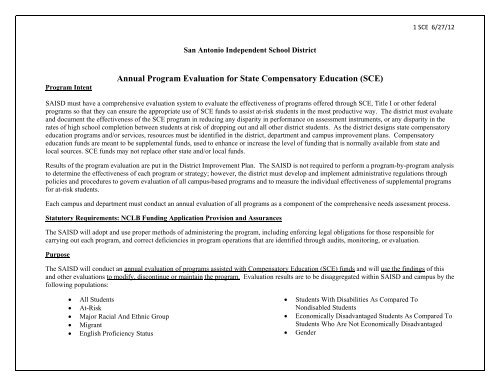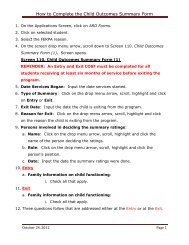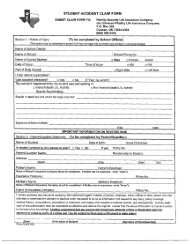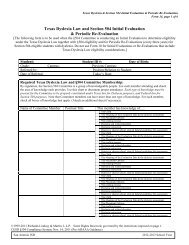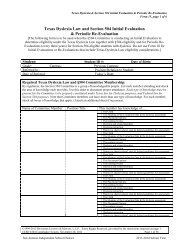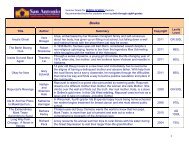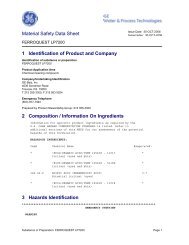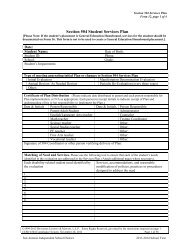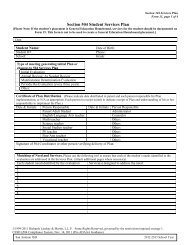Annual Program Evaluation for State Compensatory Education (SCE)
Annual Program Evaluation for State Compensatory Education (SCE)
Annual Program Evaluation for State Compensatory Education (SCE)
- No tags were found...
You also want an ePaper? Increase the reach of your titles
YUMPU automatically turns print PDFs into web optimized ePapers that Google loves.
1 <strong>SCE</strong> 6/27/12<br />
San Antonio Independent School District<br />
<strong>Program</strong> Intent<br />
<strong>Annual</strong> <strong>Program</strong> <strong>Evaluation</strong> <strong>for</strong> <strong>State</strong> <strong>Compensatory</strong> <strong>Education</strong> (<strong>SCE</strong>)<br />
SAISD must have a comprehensive evaluation system to evaluate the effectiveness of programs offered through <strong>SCE</strong>, Title I or other federal<br />
programs so that they can ensure the appropriate use of <strong>SCE</strong> funds to assist at-risk students in the most productive way. The district must evaluate<br />
and document the effectiveness of the <strong>SCE</strong> program in reducing any disparity in per<strong>for</strong>mance on assessment instruments, or any disparity in the<br />
rates of high school completion between students at risk of dropping out and all other district students. As the district designs state compensatory<br />
education programs and/or services, resources must be identified in the district, department and campus improvement plans. <strong>Compensatory</strong><br />
education funds are meant to be supplemental funds, used to enhance or increase the level of funding that is normally available from state and<br />
local sources. <strong>SCE</strong> funds may not replace other state and/or local funds.<br />
Results of the program evaluation are put in the District Improvement Plan. The SAISD is not required to per<strong>for</strong>m a program-by-program analysis<br />
to determine the effectiveness of each program or strategy; however, the district must develop and implement administrative regulations through<br />
policies and procedures to govern evaluation of all campus-based programs and to measure the individual effectiveness of supplemental programs<br />
<strong>for</strong> at-risk students.<br />
Each campus and department must conduct an annual evaluation of all programs as a component of the comprehensive needs assessment process.<br />
Statutory Requirements: NCLB Funding Application Provision and Assurances<br />
The SAISD will adopt and use proper methods of administering the program, including en<strong>for</strong>cing legal obligations <strong>for</strong> those responsible <strong>for</strong><br />
carrying out each program, and correct deficiencies in program operations that are identified through audits, monitoring, or evaluation.<br />
Purpose<br />
The SAISD will conduct an annual evaluation of programs assisted with <strong>Compensatory</strong> <strong>Education</strong> (<strong>SCE</strong>) funds and will use the findings of this<br />
and other evaluations to modify, discontinue or maintain the program. <strong>Evaluation</strong> results are to be disaggregated within SAISD and campus by the<br />
following populations:<br />
• All Students<br />
• At-Risk<br />
• Major Racial And Ethnic Group<br />
• Migrant<br />
• English Proficiency Status<br />
• Students With Disabilities As Compared To<br />
Nondisabled Students<br />
• Economically Disadvantaged Students As Compared To<br />
Students Who Are Not Economically Disadvantaged<br />
• Gender
2 <strong>State</strong> <strong>Compensatory</strong> <strong>Education</strong> 6/27/12<br />
Objectives<br />
• To evaluate the effectiveness and impact of federal funds on student achievement outcomes.<br />
• To assess the impact of federally funded strategies on campus per<strong>for</strong>mance objectives (CPOs).<br />
• To determine the degree to which program funds met the intended purposes.<br />
• To guide future program decisions.<br />
Terminology Description<br />
Identified Needs: Needs listed in the comprehensive needs assessment and reflected in the District Improvement Plan and CIP/DIP.<br />
The CNA aligns with the per<strong>for</strong>mance objective listed in the CIP.<br />
Strategies to Address Needs: Strategies and activities assisted with <strong>SCE</strong> funding and implemented to address identified needs.<br />
Expenditure: Strategies and activities specifically designated with <strong>SCE</strong> funds.<br />
Data: Data sources used to measure the impact of <strong>SCE</strong> programs on all students.<br />
Impact: <strong>Evaluation</strong> of program effectiveness and impact on identified needs and per<strong>for</strong>mance objectives related to student achievement.<br />
Recommendations: Committee recommendations to modify, discontinue, or maintain strategies and activities assisted with <strong>SCE</strong> funds.<br />
<strong>State</strong> <strong>Compensatory</strong> <strong>Education</strong> <strong>Program</strong> <strong>Evaluation</strong> Process<br />
SAISD must have a clear understanding that the evaluation is being conducted to:<br />
Column 1:<br />
Column 2:<br />
Column 3:<br />
Column 4:<br />
Column 5:<br />
Column 6:<br />
Column 7:<br />
Column 8:<br />
List all the needs which have designated <strong>SCE</strong> funds and which are identified within the comprehensive needs assessment.<br />
Using the District Improvement Plan & the CIP/DIP, identify strategies or activities used to address the disparity in<br />
per<strong>for</strong>mance on state assessments.<br />
Using the District Improvement Plan & the CIP/DIP, identify strategies or activities used to address the increase in student<br />
per<strong>for</strong>mance or achievement.<br />
Write the <strong>SCE</strong> fund amounts expended to implement the strategy or activity program.<br />
List appropriate compensatory, intensive or accelerated instructional services <strong>for</strong> students at risk of dropping out, and not<br />
per<strong>for</strong>m at grade level at the conclusion of the next regular school term.<br />
Make recommendations <strong>for</strong> modifying, discontinuing, or maintaining the strategies or activities.<br />
Conduct a Sate <strong>Compensatory</strong> Comprehensive <strong>Evaluation</strong>.<br />
Utilize data source
3 <strong>State</strong> <strong>Compensatory</strong> <strong>Education</strong> 6/27/12<br />
<strong>Program</strong> <strong>Evaluation</strong> Tool <strong>State</strong> <strong>Compensatory</strong> <strong>Education</strong> (<strong>SCE</strong>)<br />
Direction Sheet: Complete the attached chart using the in<strong>for</strong>mation below. Some columns have comment boxes.<br />
Column 1:<br />
List all needs identified in the CNA which have designated <strong>SCE</strong> funds attached to them and which are based on<br />
in<strong>for</strong>mation from data sources below. The CNA aligns with the per<strong>for</strong>mance objective listed in the CIP.<br />
Column 2:<br />
Using the District Improvement Plan & the CIP/DIP, identify strategies or activities used to address the disparity in<br />
per<strong>for</strong>mance on state assessments.<br />
Choose a response (s) below and write the number (s) in the column on the chart.<br />
1. Provide periodic training <strong>for</strong> teachers on how to identify difficulties and how to provide assistance to individual students<br />
2. Hold teacher-parent conferences <strong>for</strong> any student who has not met the standards<br />
3. Provide training <strong>for</strong> school staff on helping students meet state standards and pass state assessments<br />
4. Provide training <strong>for</strong> parents on helping their students improve their per<strong>for</strong>mance<br />
5. Provide in<strong>for</strong>mation on additional assistance that is available to the student at the school and community<br />
6. Evaluate the effectiveness of assistance provided to the student<br />
7. Coordinate district and outside resources that support teachers’ ef<strong>for</strong>ts to provide effective assistance to students<br />
8. Ensure a well defined operational process to identify students experiencing difficulty mastering the state standards<br />
9. Other, specify<br />
Column 3:<br />
Using the District Improvement Plan & the CIP/DIP, identify strategies or activities used to address the disparity in student<br />
per<strong>for</strong>mance or achievement.<br />
Choose a response (s) below and write the number (s) in the column on the chart.<br />
1. Measure student learning regularly to assure timely identification of difficulties<br />
2. Use multiple assessments to evaluate student progress and modify instruction in order to provide every student with appropriate support<br />
3. Provide regular, timely, effective and additional assistance to students experiencing difficulty mastering the state standards<br />
4. Provide differentiated instruction, designed to meet the needs of all students as a regular integrated component of core instruction<br />
5. Provide additional intervention designed to meet individual student needs<br />
6. Provide teacher collaboration time as part of the master schedule <strong>for</strong> the purpose of data analysis and improving instructional practice to<br />
ensure that all students will meet or exceed proficiency with state standards
4 <strong>State</strong> <strong>Compensatory</strong> <strong>Education</strong> 6/27/12<br />
7. Review the strategies and action steps written in the CIP with the campus staff<br />
8. Use the findings and recommendations to identify the parts of the schoolwide plan that have been/not been implemented effectively, or not<br />
at all<br />
9. Solicit the input of all stakeholders in identifying more effective strategies to achieve the identified goals of students in need<br />
10. Identify any additional training that is needed to improve implementation<br />
11. Determine if additional resources are needed to implement the revised improvement plan and, if so, how they will be obtained<br />
12. Re-establish responsibilities and timelines <strong>for</strong> implementing the revised plan<br />
13. Communicate to all stakeholders what has been incorporated into the revised plan to meet the needs of at risk students<br />
14. Review the implementation design that was used and make changes as appropriate to reflect plan modifications to meet the needs of at risk<br />
students in preparation <strong>for</strong> the following year’s evaluation<br />
15. Other, specify<br />
Column 4:<br />
List appropriate compensatory, intensive or accelerated instructional services <strong>for</strong> students at risk of dropping out, and not<br />
per<strong>for</strong>m at grade level at the conclusion of the next regular school term.<br />
Choose a response (s) below and write the letter (s) in the column on the chart.<br />
A. Specialized reading or mathematics programs and /or materials<br />
B. Specialized software<br />
C. Additional staff and equipment<br />
D. Tutorials<br />
E. Class-size reduction<br />
F. Computer-assisted instruction<br />
G. Specialized staff development to train personnel who are working with students at risk of dropping out of school<br />
H. TAKS/STARR remediation<br />
I. Individualized instruction<br />
J. Extended day sessions <strong>for</strong> prekindergarten<br />
K. Accelerated instruction<br />
L. Extended day, week, or year programs<br />
M. Field trips<br />
N. Other, specify<br />
Column 5:<br />
List the amount of funds expended to implement the strategy or activity. If the funds are lumped together, give your best<br />
estimate <strong>for</strong> dollars expended <strong>for</strong> the strategy or activity. If funds are specifically designated <strong>for</strong> the strategy or activity, list<br />
that amount in the column.
5 <strong>State</strong> <strong>Compensatory</strong> <strong>Education</strong> 6/27/12<br />
Column 6:<br />
Make recommendations <strong>for</strong> modifying, discontinuing, or maintaining the strategy or activity.<br />
Choose a response (s) below and write the letter (s) in the column on the chart.<br />
A. Modify<br />
B. Discontinue<br />
C. Maintain<br />
D. Other, specify<br />
Column 7:<br />
Comprehensive evaluation addresses the strengths and weaknesses of the program.<br />
Choose a response (s) below and write the number (s) in the column on the chart.<br />
1. Funding was adequate<br />
2. Funding was inadequate<br />
3. Student per<strong>for</strong>mance improved<br />
4. Student per<strong>for</strong>mance did not improve<br />
5. Teacher per<strong>for</strong>mance improved<br />
6. Teacher per<strong>for</strong>mance did not improve<br />
7. Stakeholders participated<br />
8. Stakeholders did not participate<br />
9. Professional development and training was effective<br />
10. Professional development and training was ineffective<br />
11. Strategy, initiative and/or program met the students’ needs<br />
12. Strategy, initiative, and/or program did not meet the students’ needs<br />
13. Timing of the intervention or implementation used was appropriate<br />
14. Timing of the intervention or implementation used was inappropriate<br />
15. Amount of time given <strong>for</strong> the intervention or implementation was sufficient<br />
16. Amount of time given <strong>for</strong> the intervention or implementation was insufficient<br />
17. Other, specify
6 <strong>State</strong> <strong>Compensatory</strong> <strong>Education</strong> 6/27/12<br />
Column 8:<br />
Data Sources<br />
Choose a response (s) below and write the number (s) in the column on the chart.<br />
1. District Improvement Plan<br />
2. CIP/DIP<br />
3. Student achievement data<br />
4. <strong>State</strong> Assessment Data<br />
5. TELPAS and AMAO Results<br />
6. PBMAS and DVM reports<br />
7. SAT/ACT/PSAT results<br />
8. Advanced Course/ Dual Enrollment Data<br />
9. Standardized Tests<br />
10. AEIS and AYP Data Tables<br />
11. Completion Rate<br />
12. Promotion/ Retention Rates<br />
13. Evidence of <strong>Program</strong> Implementation<br />
14. Surveys<br />
15. Demographic Data<br />
16. ARMS<br />
17. Crystal Enterprises<br />
18. ITTCS<br />
19. I Data Portal<br />
20. Self Assessment<br />
21. Observations<br />
22. Interviews<br />
23. Group Discussions<br />
24. <strong>Evaluation</strong>s<br />
25. Other, specify


